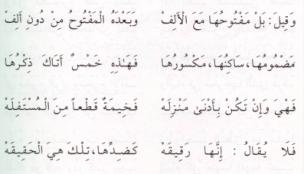Velarization
(Heaviness) and Lightness (Part1) 
The
definition of tafkheem: Fattening
Its applied definition: It
is a heaviness that enters the body of the letter, so that the mouth is filled
with its reverberation (echo). The method of making a letter have the
characteristic of tafkheem is: elevating the posterior tongue to the roof of
the mouth (soft palate), creating more space between the roof of the mouth and
the bottom of the mouth, and focusing the pressure of the letter to the roof
of the mouth.
The
linguistic definition of tarqeeq
: Thinness
Its applied definition:
It is a thinness that enters the body of the letter, so the mouth
is not filled with its reverberation (echo).
The
Arabic letters are divided into three groups as to tafkheem and tarqeeq:
1.
Letters that
always have tafkheem. These are
the seven letters in the group
 .
They are also called the tafkheem letters.
.
They are also called the tafkheem letters.
2.
Letters that have tafkheem sometimes and tarqeeq other times.
a)
The lengthened alif.
b)
The
 in
the Glorious name of
in
the Glorious name of
 .
.
c)
The

3.
Letters that always have tarqeeq.
This group consists of the rest of the Arabic alphabet.
The
Letters That Always Have Tafkheem
The
seven letters of
 group make up this
category. The letters of
group make up this
category. The letters of
 are
are
 .
These letters do not all have the same degree if tafkheem, instead
there are differences according to the letter’s
characteristics, and the strength or weakness of these characteristics.
Every time a letter has a strong characteristic, its tafkheem is
stronger.
.
These letters do not all have the same degree if tafkheem, instead
there are differences according to the letter’s
characteristics, and the strength or weakness of these characteristics.
Every time a letter has a strong characteristic, its tafkheem is
stronger.
 letters
letters
 ) ) are
stronger in tafkheem than the rest of
) ) are
stronger in tafkheem than the rest of
 letters due to the
adhesion of the tongue to the roof of the mouth in conjunction with the
elevation of the tongue. The
ranking of
letters due to the
adhesion of the tongue to the roof of the mouth in conjunction with the
elevation of the tongue. The
ranking of
 letters from
strongest is
letters from
strongest is
 then
then
 , then
, then
 , then
, then
 , then
, then
 , then
, then
 , then
, then
 .
.
Levels of Tafkheem
There
are two different schools of thought when it comes to tafkheem.
Both are correct, but the reader should follow one or the other in
their reading.
Three Levels of Tafkheem
This
school of thought has three different levels in tafkheem.
The strongest being the tafkheem letter that has a fat-h, the second
being the tafkheem letter with a dhammah, and the third level, the tafkheem
letter with a kasrah. The saakin
tafkheem letter follows the level of tafkheem of the vowel on the letter
before it. This means if the
tafkheem letter is saakin, and the letter before it has a fat-ha, then the
tafkheem letter will be at the highest level of tafkheem (as the
 in:
in:
 )
. The saakin letter of tafkheem preceded by a dhammah would have the second
level of tafkheem (as the
)
. The saakin letter of tafkheem preceded by a dhammah would have the second
level of tafkheem (as the
 in :
in :
 .
The saakin tafkheem letter
preceded by a kasrah is at the lowest level of tafkheem (such as the
.
The saakin tafkheem letter
preceded by a kasrah is at the lowest level of tafkheem (such as the
 in
:
in
:
 .
Sheikh Mohammed Al-Mutawali described these levels in the following
lines:
.
Sheikh Mohammed Al-Mutawali described these levels in the following
lines:

(Then
the heavy ones come
with three levels and they are
The one with a fath,
then the dhammah, then the kasrah,
and the saakin follows what
preceded it
So
what came before it in a vowel,
then assume for it as a harakah that vowel.)
The Five Levels of Tafkheem
The
second school of thought of tafkheem has five levels.
The highest level being a tafkheem letter being followed by a long alif
(for example the
 in:
in:
 ).
The second level is a tafkheem letter with a fathah on it (such as the
).
The second level is a tafkheem letter with a fathah on it (such as the
 and
and
 in:
in:
 ).
The next level that of a tafkheem letter having a dhammah (as in
).
The next level that of a tafkheem letter having a dhammah (as in
 ).
The next level is a tafkheem letter with a sukoon (for example
).
The next level is a tafkheem letter with a sukoon (for example
 ).
And the last level, that of a tafkheem letter with a kasrah (such as the
).
And the last level, that of a tafkheem letter with a kasrah (such as the
 in:
in:
 ).
This school of thought as to tafkheem varies from the previous three level
school in a few ways. First, the
tafkheem letter with a fathah has two categories, that of a fath followed by
an alif, and then a fathah not followed by an alif.
This school also varies from the previous one in that the tafkheem
letter with a sukoon has its own level of tafkheem, whereas the other school
of thought has the saakin letter following the tafkheem level of the vowel on
the letter preceding it. This means that there will be a difference of
tafkheem between the saakin letters in this group, which are not affected by
the vowel of the letter preceding it, and the other group which is totally
affected by the vowel on the letter preceding it.
For example, a saakin tafkheem letter preceded by a fathah in the three
level school of thought, will have the highest ranking of tafkheem, whereas a
saakin tafkheem letter of this five level school of thought, will have the 4th
degree of tafkheem. Ash-Sheikh Al-Mutawali described the five levels of
tafkheem in the following lines:
).
This school of thought as to tafkheem varies from the previous three level
school in a few ways. First, the
tafkheem letter with a fathah has two categories, that of a fath followed by
an alif, and then a fathah not followed by an alif.
This school also varies from the previous one in that the tafkheem
letter with a sukoon has its own level of tafkheem, whereas the other school
of thought has the saakin letter following the tafkheem level of the vowel on
the letter preceding it. This means that there will be a difference of
tafkheem between the saakin letters in this group, which are not affected by
the vowel of the letter preceding it, and the other group which is totally
affected by the vowel on the letter preceding it.
For example, a saakin tafkheem letter preceded by a fathah in the three
level school of thought, will have the highest ranking of tafkheem, whereas a
saakin tafkheem letter of this five level school of thought, will have the 4th
degree of tafkheem. Ash-Sheikh Al-Mutawali described the five levels of
tafkheem in the following lines:

(and
it is said, no the one with the fat-hah followed by an alif
and after it a fat-hah without an alif
the
one with the dhammah, the saakin, the one with the kasrah;
so that is five, its mention came to you.
and
if it is in the lowest level
It has tafkheem, cut off from the istifaal (lowering of the tongue)
So it cannot be said it has tarqeeq
Like its opposite, that is the truth.
Next
tidbit lesson, insha' Allah will continue with tafkheem and tarqeeq,
moving on to explain the letters that sometimes have tafkheem and sometimes
tarqeeq.
